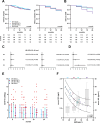Association of body mass index and clinical response in patients receiving ofatumumab for treatment of multiple sclerosis
- PMID: 40050009
- PMCID: PMC12322383
- DOI: 10.1136/jnnp-2024-335673
Association of body mass index and clinical response in patients receiving ofatumumab for treatment of multiple sclerosis
Abstract
Background: The impact of body weight on disability progression rates among patients receiving ofatumumab was not evaluated yet.
Methods: Among patients from a multicentre prospective cohort, baseline demographics were compared among body mass index (BMI) quartiles as well as proportions of clinical relapses, MRI lesions and disability worsening during follow-up.
Results: 536 patients from four centres were included. Baseline demographics were evenly distributed among patients. Proportions of relapses and new/enlarging MRI lesions were comparable among BMI strata.Confirmed disability worsening was significantly more abundant among patients from the 4th BMI quartile (BMI ≥29.2 kg/m2; adjusted HR: 3.33 (95% CI: 1.72 to 6.42; p<0.001). Relapse-associated worsening was not substantially different among relapsing patients from different BMI strata (HR: 1.19 (95% CI: 0.40 to 3.52; p=0.750)). Yet, progression independent from relapse activity was more likely in patients from 4th BMI quartile (HR: 2.00 (95% CI: 1.47 to 2.70; p<0.001)).Body weight (4th body weight quartile: ≥84.5 kg) was not associated with disability worsening (adjusted HR: 1.91 (95% CI: 0.97 to 3.76; p=0.060). Ofatumumab serum levels were lower in patients with higher BMI as well.
Conclusions: Inflammatory disease outcomes did not differ but disability progression was more frequent in the highest BMI quartile (BMI >29.2 kg/m2). This was associated with lower ofatumumab serum levels. Since body weight itself was not predictive, we assume that body fat composition is critical for ofatumumab effectiveness.
Keywords: MULTIPLE SCLEROSIS; NEUROIMMUNOLOGY.
© Author(s) (or their employer(s)) 2025. Re-use permitted under CC BY-NC. No commercial re-use. See rights and permissions. Published by BMJ Group.
Conflict of interest statement
Competing interests: P. Winter reports no disclosures.F. Axhausen reports no disclosures.S. Wolff received honoraria for lecturing from Mylan and Novartis and received research support from Novartis.A. Willison received honoraria for lecturing and consulting from Alexion, Bayer Healthcare, Biogen, Bristol-Mayers Squibb/Celgene, Horizon, MedDay, Merck Serono, Mylan, Novartis, Roche, and Sanofi Genzyme, as well research support from Teva, Merck Serono, and Novartis.S. Räuber received travel grants from Merck Healthcare Germany GmbH, Bristol Myers Squibb, and Alexion Pharmaceuticals. She served on a scientific advisory board from Merck Healthcare Germany GmbH and received honoraria for lecturing from Roche. Her research was supported by Novartis, ‘Stiftung zur Förderung junger Neurowissenschaftler’, and ‘Else Kröner-Fresenius-Stiftung’.F. F. Konen received travel compensation from Merck, Novartis, BMS and Alexion as well as a German Research Foundation (DFG)–funded fellowship as part of the Clinician Scientist Program (PRACTIS) at Hannover Medical School.S. Schreiber reports no disclosures.T. Ruck received honoraria for lectures, adboards and travel support from Alexion, Argenx, Biogen, Celgene, BMS, Genzyme, Merck Serono, Novartis, Novartis, Roche, Sanofi-Aventis and Teva.M. Pawlitzki received honoraria for lecturing from Alexion, Argenx, Biogen, Bayer, Hexal, Janssen, Novartis, Sanofi and Merck. He received research funding from BiogenH. B. Huttner received personal honoraria and/or unrestricted research grants from Portola Pharmaceuticals from Boehringer Ingelheim, Daiichi Sanyko, Bayer AG, Novartis, Astrazeneca and CSL Behring.C. Kleinschnitz received lecture and consultancy fees from Biogen, Roche, and Novatis. T.H. received lecture and consultancy fees from Biogen, Roche, and Novatis, as well as research support from Biogen, Roche, and Novatis Gene Therapies.T. Skripuletz reports research support from the German Ministry for Education and Research (BMBF: CurePML01EN2302), Bristol Myers Squibb Foundation for Immuno-Oncology (FA 19-010), Claudia von Schilling Foundation for Breast Cancer Research, Else Kröner Fresenius Foundation, Genzyme Neuroimmunology Fellowship, Hannover Biomedical Research School (HBRS), VHV Foundation, Alnylam Pharmaceuticals, CSL Behring, Novartis; honoraria for lectures and travel expenses for attending meetings from Alexion, Alnylam Pharmaceuticals, argenx, Bayer Vital, Biogen, Bristol Myers Squibb, Celgene, Centogene, CSL Behring, Euroimmun, Grifols, Hexal AG, Janssen-Cilag, Merck Serono, Novartis, Pfizer, Roche, Sanofi, Siemens, Swedish Orphan Biovitrum, Teva, Viatris; consultant fees from Alexion, Alnylam Pharmaceuticals, Biogen, Centogene, CSL Behring, Grifols, Hexal AG, Janssen-Cilag, Merck Serono, Novartis, Roche, Sanofi, Swedish Orphan Biovitrum, Viatris.R. Pul received honoraria for lecturing and consulting from Alexion, Bayer Healthcare, Biogen, Bristol-Mayers Squibb/Celgene, Horizon, MedDay, Merck Serono, Mylan, Novartis, Roche, and Sanofi Genzyme, as well research support from Teva, Merck Serono, and Novartis.S. G. Meuth received honoraria for lecturing and travel expenses for attending meetings and has received financial research support from Bayer, Biogen Idec, Sanofi-Aventis, Bayer Schering, Merck Serono, Novo Nordisk, Genzyme, MSD and Teva.S. Pfeuffer received travel grants from Biogen, Roche, Sanofi-Aventis and Merck, lecturing honoraria from Merck, Roche, Hexal, Alexion, Novartis, Sanofi-Aventis, and Biogen, and research support from Diamed, Merck, Biogen, Novartis, and the German Multiple Sclerosis Society North-Rhine-Westphalia.
Figures

References
-
- Kappos L, Wolinsky JS, Giovannoni G, et al. Contribution of Relapse-Independent Progression vs Relapse-Associated Worsening to Overall Confirmed Disability Accumulation in Typical Relapsing Multiple Sclerosis in a Pooled Analysis of 2 Randomized Clinical Trials. JAMA Neurol. 2020;77:1132–40. doi: 10.1001/jamaneurol.2020.1568. - DOI - PMC - PubMed
-
- Kappos L, Montalban X, Coyle P, et al. Ofatumumab Reduces Disability Progression Independent of Relapse Activity in Patients with Relapsing Multiple Sclerosis (2299) Neurology (ECronicon) 2021;96 doi: 10.1212/WNL.96.15_supplement.2299. - DOI
Publication types
MeSH terms
Substances
LinkOut - more resources
Full Text Sources
Medical
